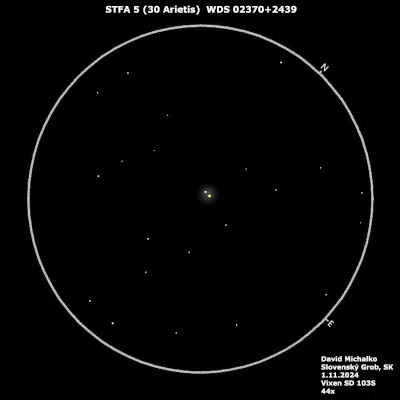Ari
☀6.5/7.02mag
Ø
37''

30 Arietis is a quadruple physical system located 136 light-years away from us. The primary component is a spectroscopic binary 30AriA consisting of a main-sequence star of spectral type F5V with a mass of 1.31 times that of the Sun and a radius of 1.37 times that of the Sun. Its companion is a red dwarf with a mass of only 0.15 times that of the Sun. The components orbit their common center of mass in 26.6 hours. The secondary component is a very tight, but still visual, binary star 30AriB which can only be resolved by telescopes with adaptive optics. It consists of a main-sequence star of spectral type F7V with a mass of 1.16 times that of the Sun and a radius of 1.13 times that of the Sun, along with a companion red dwarf. The components are approximately 22 AU apart, a distance similar to that between Uranus and Neptune. The orbital period of the pair is estimated to be over 100 years. 30AriA and 30AriB are separated by about 38" on the sky, which corresponds to a physical distance of approximately 1500 AU. Both primary components are about the same distance from Earth and have very similar motion, implying they are gravitationally bound, with an estimated orbital period of around 34,000 years—forming a common proper motion (CPM) pair. In 2009 an object 30AriBb was discovered orbiting the primary component of 30AriB at a distance of 1 AU with an orbital period of around 345 days. Initial measurements suggested the object's mass to be around 10 or more Jupiter masses, classifying it as a brown or red dwarf. However in 2020 after more precise measurements, the object was reclassified as a planet—a gas giant with a mass of 6.6 Jupiter masses.
103mm - 30 Arietis is a very wide system, so the two primary components are easily observable even in the smallest telescopes. I observed the primary component as yellow-white and the secondary component as white.